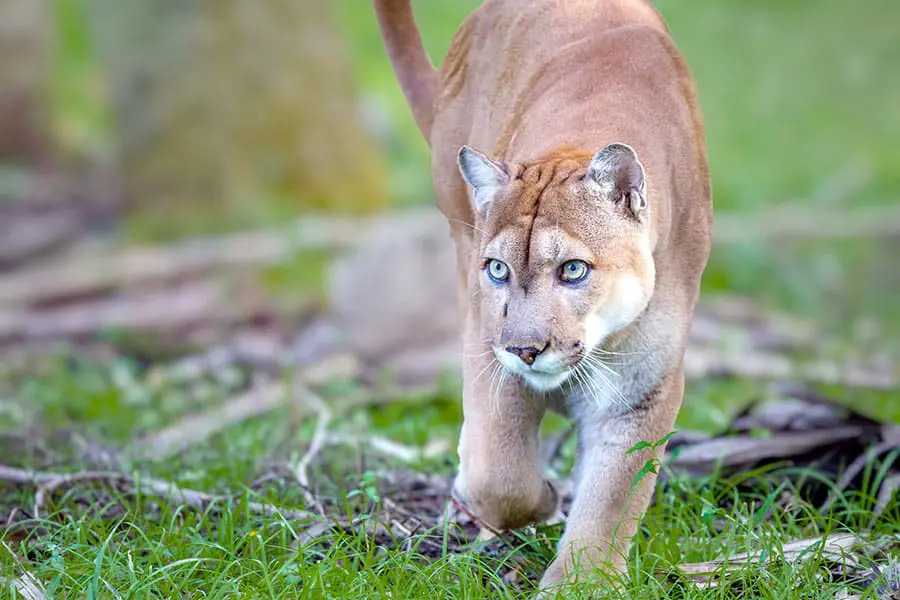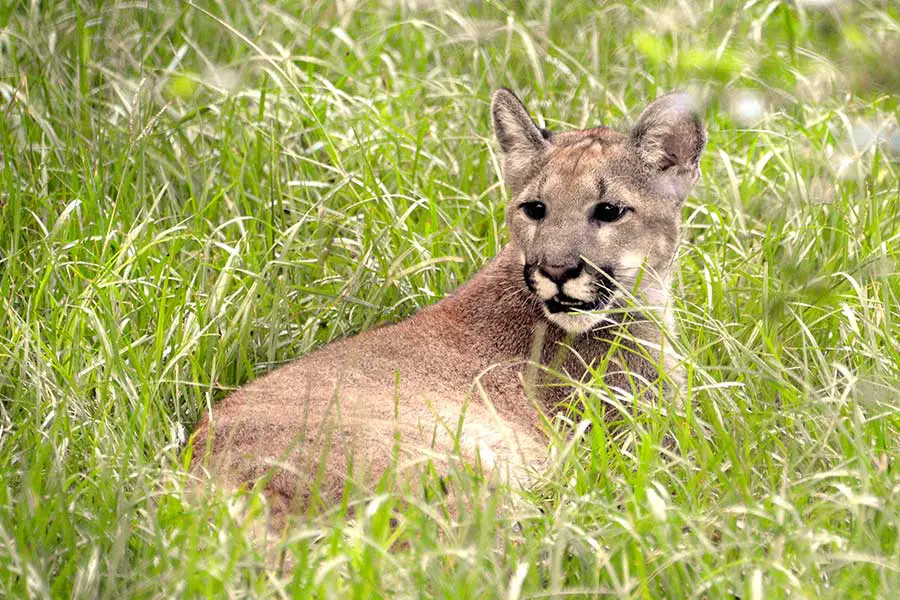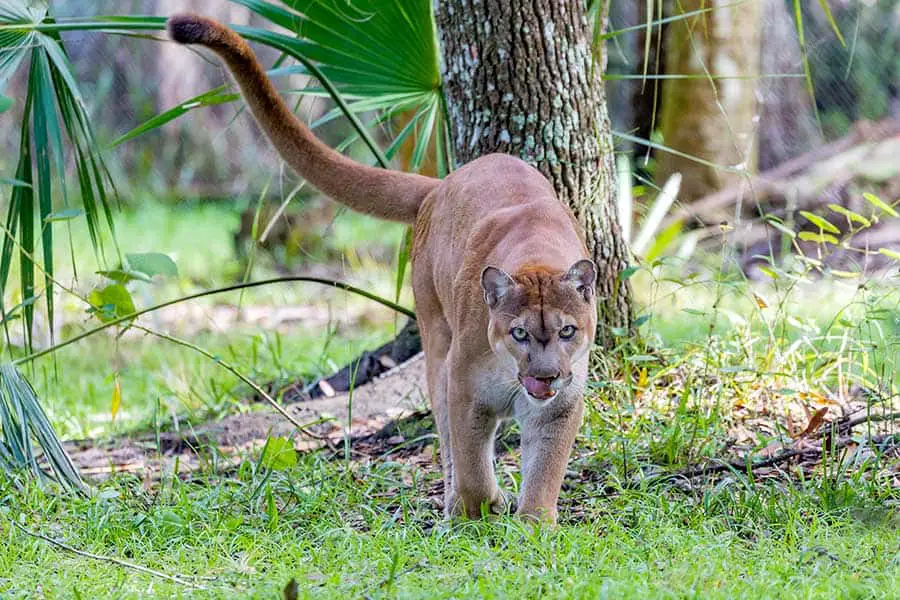
Florida is well known for its variety of interesting wildlife. From beautiful and often tropical birds to the famous alligators and crocodiles, Florida hosts an astonishing variety of wildlife. But where can one go in Florida to find the famed Florida panther?
Florida panthers live in the southern tip of Florida, down by the Everglades. The Big Cypress National Preserve provides a 729,000-acre habitat for the panther and is an excellent place to go if you wish to see a Florida panther in the wild.
So what is a Florida panther exactly? Is it a kind of mountain lion, or more like a bobcat? What do they eat, and are they dangerous to people? Continue reading to learn more about these fabulous felines.
Florida Panthers: Where Do They Live?
Panthers are large, beautiful predatory cats that make their home in South Florida. A subspecies of the Puma (Puma Concolor), the Florida panther (Puma Concolor Coryi), is the only large cat found east of the Mississippi.
These cats used to range throughout the gulf coast states and into Louisiana and Arkansas, but excessive hunting, unchecked development, and other threats pushed the species to their last remaining stand of territory in South Florida.
The current range of the Florida panther includes about 3,548 square miles in the southern tip of the state near the Everglades, a significantly smaller area than their original known range.
Currently, panthers are an endangered species. Isolation of their population from other panther and puma species has reduced genetic diversity, and the destruction of their natural habitat has put tremendous pressure on this species.
It remains to be seen whether the Florida panthers can survive long-term as a species, but scientists and conservationists in Florida are working very hard to ensure a future for this magnificent animal.
Florida panthers are opportunistic ambush predators. What does that mean? It means that they prefer to stalk their prey and that they will stalk most any prey that seems viable to them. Their quarry usually includes animals like deer, but Florida panthers will also eat armadillos, hogs, and raccoons.
To effectively stalk their prey, panthers like to range through a territory that offers them good cover and concealment. Therefore, they prefer areas with tall grasses, trees, and other cover. In Florida, that can mean anything from cypress swamps to pinelands or forests. As I mentioned earlier, the Big Cypress National Preserve has the type of habitat that panthers like and is a perfect place to try to see one.
Panthers are big cats. On average, a male panther weighs between 100 and 150 pounds; females are a little smaller and weigh between 70 and 100 pounds. Panthers usually stand about 24 inches high at the shoulder and are about 6 to 7 feet long from their nose to the tip of their tail.
Other Posts of Interest
- Does Florida Have Pythons?
- Is It Illegal To Take Sand From The Beach In Florida?
- Does Florida Have Bayous?
- Do You Need A License To Fly A Drone In Florida?
Phenomenal Florida Fun Fact: While significantly larger than your average housecat, Florida panthers behave a lot like their smaller cousins, including their tendency to pounce on unwary prey. Panthers can leap up to fifteen feet in a single jump.
How Many Kittens Does a Florida Panther Have
Florida panthers mate during Florida’s pleasant winter months, usually between November and March. While they typically are very territorial animals, during this time, they will leave their territory to find a mate. Once this is accomplished, the female panther will become pregnant and usually bears a litter of one to three kittens after a gestation of about three months.
When they are born, the kits are unable to see for the first week to ten days until their eyes open. They are also distinctively colored, with dark spots and stripes that help them hide from dangerous predators. The kits grow fast, becoming adults in about 12 months, during which time they shed their kitten-like appearance and begin to look more like a mature cat. Kits stay with their mother for about 18 months before setting off to find their own territories.
Are Florida Panthers Dangerous?

Panthers are large predatory cats. They are capable of killing human beings, but it is important to note that they are not habitual predators of humans. In fact, there are no documented cases of a Florida panther killing a human being. Florida panthers are known for being reclusive and shy, and they are generally fearful of human beings.
If you live in or visit panther country, you can easily keep yourself safe by minimizing the things that attract panthers. For example, panthers are ambush predators. Therefore, removing brush or foliage that could provide cover for a large cat helps deter them from your land. Similarly, removing any brush or other food that attracts deer will keep panthers away, as panthers like to eat deer.
Panthers will also eat hogs, raccoons, livestock, and small pets. Keeping your property clean and free of garbage or other things that will attract panther prey will keep these cats away. If you ever encounter a panther, stay away from it – chances are it will take evasive action to avoid you.
Can Florida Panthers be Black?
Panthers are naturally camouflaged for their environment and usually come in a tan, brownish color. Some panthers have been spotted with rusty or dark-colored fur or black tips on their tails, muzzle, or ears. Panther kittens have many black stripes and spots that fade into their fur as they grow up. However, there has never been a documented case of a Florida panther being all black in color.
What Do Florida Panthers Eat?
Like most big cats, Florida panthers are carnivorous. These graceful cats love to stalk their prey, and so they prefer areas with grassy shrubs or big trees to camouflage them. Their preferred prey includes deer and wild hogs, both of which are plentiful in south Florida. They will also eat armadillos, raccoons, and rabbits that cross their path.
Panthers are opportunistic predators. They will also eat livestock such as chickens or goats, as well as household pets that cross their paths, so it is vital to secure your dogs and cats if you live in panther territory.
Are Florida Panthers Endangered?

Florida panthers are endangered. Overdevelopment of their natural habitat by housing, industry, infrastructure, and agriculture has caused significant stress to this species. By the 1970s, biologists estimated that there were only about 20 of these big cats left. Conservation efforts have led to a current population of somewhere around 120 panthers, but they are still very much endangered.
Panthers will be de-listed as an endangered species when the population reaches three groups of 240 or more individuals. Recently, a female panther was confirmed to have had kits in Charlotte County, and some males have been spotted further north. However, for the foreseeable future, this cat remains in danger of extinction.
It is not currently legal to hunt, trap, or otherwise kill panthers in Florida. These animals are protected as an endangered species, and Florida law provides penalties including prison time and up to a $100,000 fine for people who intentionally injure or kill panthers.
Unfortunately, these cats sometimes end up being struck by cars. In the exceedingly unlikely event that you hit a panther with your vehicle, pull over and contact law enforcement immediately.
How Long Do Florida Panthers Live?
The wilderness of Florida can be unforgiving, and Florida panthers are navigating a world that poses all kinds of new threats. While they would likely survive longer in captivity, a typical Florida panther will live for about 12 years in the wild. Sadly, one of the biggest threats to the Florida panthers is human activity. Panthers are often struck by cars when crossing the road in South Florida, and the development of their habitat is leaving them with fewer and fewer places to go.

Do Panthers Roar?
Unlike many big cats, Florida panthers can’t roar. The anatomy of their throat does not allow them to produce a roar. To communicate, panthers will chirp, whistle, growl, hiss, scream, or even purr. Females in heat will produce familiar yowls and wails to signal that they are receptive to mating. Otherwise, these cats are surprisingly quiet.
Everglades Cats, Now and Forever
While there has been mention of the endangered state of these cats in this post, many serious scientists, conservationists, and citizens in the great state of Florida have dedicated themselves to helping these beautiful animals.
Indeed, Florida is so proud of the Florida panther that it is the Official State Animal of the Sunshine State. I bet you thought it was the alligator (a logical guess), but the charismatic panther was awarded this recognition in 1982. Since then, the breeding population of Florida panthers has expanded and grown, from a low of about 20 cats to current numbers of about 120.
Panthers have found great success in Florida’s Everglades. While they are beginning to range further north in a sign of great hope, the majority of their population still finds South Florida to be a cozy spot to settle and roam. So next time you’re in South Florida enjoying the beaches or cities, take a day or two and venture into the Everglades. You might even just get lucky enough to see a Florida panther with your own two eyes.





